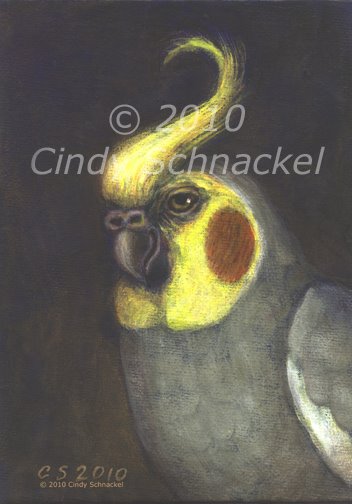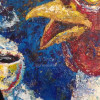CREATIVE
Q: Tell us a little about yourself. Who are you and what do you do?
A: I’m Cindy Schnackel, and I’ve been an artist as long as I can remember, but professionally since the 1980s. At first, I worked in the art industry, painting theater sets, faux finishes, murals and TV/movie props. Now, I just do my personal art, which I’d describe as humorous surrealism, sometimes with a little cartoon thrown in. I show and sell in the Phoenix, Arizona, area.
Q: What art technique do you use, and what motivated you to use that technique?
A: Drawing has always been a favorite activity, clay, too. I can barely keep myself from doodling if there’s anything around to do it with. I took up painting in my late teens, and have done ceramics and sculptural work off and on since then, too. I like to use reclaimed material, like empty containers as sculpture armatures, wood scraps to paint on.
Regardless what medium it is, my technique is pretty subconscious. I just ‘start.’ Even if there’s some plan, I let it take its own course. It may include many methods depending on complexity and the look that seems to be right for that particular piece. I work in a wide range of sizes, but the majority are small. The spontaneity and elements that come through by not over thinking it almost always surprise me in a good way. I’ve got a habit of stopping a piece midway if I lose interest and just gessoing over it. If I just don’t feel the energy to paint or sculpt, I will do things like prime painting panels, or attach hanging hardware.
I like media that is fast, not too process-intensive. Acrylics are so versatile they’re my favorite. I don’t know when I first learned a bit about the old masters, probably started in high school, definitely in college, but I’ve adopted a bit here and there, of their painting techniques, such as glazing. I use a similar layering method to build up colored pencil drawings, and sometimes combine colored pencil and thin acrylics.
On my blog you can read about the process of making sculptures from a lot of things that were just lying around the house or destined for the trash. cindyschnackel.wordpress.com

Q: When did you decide you wanted to be an artist? And has the internet become a good or bad aspect to life as an artist?
A: Since I was very little, I always knew I was an artist. At varying times I’ve been more serious about doing it as a career. The first big commitment was in college, to choose art as a major, then work in the art industry. Later, it required a new commitment to learn how to treat my art as a business.
The internet is a huge benefit for marketing art work. It’s fortunate that much of the local art community is on one social media platform, so I’ve been able to do almost all of my online professional networking there. (Facebook) This has led to numerous in person meetings, shows, and sales.
The only really bad aspect of the internet is how rampant infringement has become. If an artist does things that catch infringers’ eyes, and does nothing to address it, their work will be all over, used for all sorts of things, without pay or permission. It might also be used for things the artist would find appalling. A minor problem with the internet is that it can be a time thief, if you let it.
Q: What do you dislike about the world of art?
A: I feel blessed to be part of a great local art community, and to have had the successes I have. There are numerous art worlds. The local ones, the investment art world, and that of art industry jobs, etc. The hype in the high end (investment) art world, that makes rock stars out of people with little or no talent or originality is a minor irritation. It would be a bigger irritation if it infected the more practical local art worlds, where most buyers buy because they like something, not because they think it’ll go up in value.

Q: What is the toughest thing about being an artist?
A: Commitment. Taking one’s art seriously enough that it won’t fade away to a hobby, something to do when it’s convenient. Art is a passion. If not exercised, an artist won’t likely reach much of their potential. When you’re young and starting out, there’s all the advice not to go into art. That is made harder now due to high tuition.
Q: What’s your message to the World?
A: Be true to yourself. I know it’s kind of trite but it’s important to be genuine.
INFRINGEMENT
Q: What was your first case of a piece of art being infringed upon?
A: Several years ago, before google had a reverse image search, an online acquaintance happened to find someone using one of my paintings. I don’t even remember what it was being used for. The person gave me a link about sending DMCA takedowns, which I did, and it was removed from the infringer’s site.
Q: How did you feel about someone stealing your artwork and making money from your hard work?
A: Surprised, offended, stressed. As it has happened more, less surprise, still offended, and when it happened a lot or if it’s a particularly bad one, lots of stress. Dealing with infringement is time and energy lost that should’ve been spent on making new art, or any number of better things.
Q: Do you feel it’s a necessary part of the market, to allow for free advertising?
A: No. It’s not free advertising for the artist whose work is infringed, because usually the artist isn’t credited, and sometimes the use is for something that would damage the artist’s reputation. It is also a bad idea to give the impression you work for free or that you don’t enforce your rights, as everyone who gets this message will certainly take that much more advantage. Even uncredited ‘sharing’ fails to help promote the artist, since many images are unidentifiable on their face. Metadata is often stripped out by uploading it to a site. Unidentified images seem at higher risk of being taken by infringers.
Q: What would you say to the infringers if you had the chance?
A: It’s more effective to just send a DMCA takedown and be done with it, especially since some infringers argue, ignore you, or even retaliate. Their site host is usually more professional to deal with. On occasion, infringers contact me to rant about the takedown. I send them a link on copyright myths and usually never hear back. For me to think it was worth my time to say anything to infringers, I’d first have to be convinced they were open to it, and that rarely happens. Most see themselves as the victim.

Q: How do you think this situation could be resolved?
A: As with any law there’s no way to entirely stop people from breaking it, but practical enforcement options would probably send a message better than just hoping infringers read articles on copyright myths and voluntarily comply. In most countries, copyright law is on the artist’s side, technically. It’s just expensive, stressful, and time consuming to enforce. I addressed this issue in the US Copyright Office’s public commentary period this year and last, on copyright reform, and the DMCA, and in about 2012 on the proposed small claims process.
Q: Have you ever been approached about infringement you have caused, or sent an email?
A: No.
COPYRIGHT
Q: What is your view on copyright?
A: On paper the copyright laws are usually pretty good. They give the creators many important rights that incentivize more creation and allow for making a living from it. The law also gives the public some limited rights to use or refer to it, (‘fair use,’ usually very poorly understood by the public).
The problems arise when people assume that what they heard, or would like to believe, is the law, instead of what the law really is. Or, when they don’t care! Then, the artist has to enforce their rights with very limited options. A huge obstacle in the path of USA artist is registration, which is optional to have copyright, but required to sue for statutory damages (those beyond actual damages). Even once registered there can be problems, so many in fact that I feel much of what artists buy with registration is a false sense of security. Registration is outdated and obstructive; it needs to go. In the US, in all kinds of
civil, money damage cases, the amount you can demand in damages greatly influences whether a lawyer can even afford to help you. While most individual cases have very low money damages, hundreds or thousands of little cases add up to “death by 1000 paper cuts,” and that’s a substantial loss for some artists. Again, it’s not about money alone; it’s also about lost time and energy that would otherwise be spent working. (And reputation damage sometimes.)
This needs to change. Copyright is one of the few civil type cases in the US where you can’t really sue for small damages. No doubt, the lack of meaningful consequences for most infringers has helped fuel myths about what one can legally do with other people’s work. A proposed small claims process in the US is being considered. I feel it’s needed, but perhaps getting rid of registration as a barrier would be better, (other countries that have eliminated it could be used as a model). Also, the proposed small claims process as written so far, lets an infringer choose not to be sued, which seems counterproductive.

Q: Have you ever innocently, or without knowledge of copyrighted laws used other’s material for your own work?
A: Not that I know of, at least not as an adult. When I was quite young, there was an unwritten kid rule that copying to pass off as your own was really bad. We didn’t have the means to display work to the whole world (no internet!) or sell it on a Print On Demand site, but if we had, I might have learned the hard way about takedowns. Since those days, I’ve read up on copyright, public domain, and fair use, and believe I’ve erred on the side of caution. Most of my work is imaginary and unrealistic so there’s not even much need to use references. When I do need a close reference I’ve found many photographers are happy to grant permission.
Q: How do you protect your own work against copyright theft?
A: Large, central watermarks have stopped a lot of new infringements, (without hurting sales). A great analogy is that we lock our doors because we know it prevents most burglaries, not because we believe it will prevent all. They ‘can’ be removed, but most infringers seem to be of the casual type, not going to go to that length, and who are reminded by the watermark that it’s not theirs to use. Removing watermarks can make a civil case a criminal one with even more penalties; attorneys use that to advantage.
Q: Do you think companies on the web do enough to protect artist’s work?
A: Some are quite good about it. Others have a reputation for playing games or ignoring valid takedowns. Even here in the US where the Digital Millennium Copyright Act (DMCA) is law, we have site hosts that aren’t very compliant. Internet companies that make money from other peoples content are particularly involved in lobbying to weaken copyright owners’ rights, and often do it under the guise of issues like free speech, when it’s really about their profit. Perhaps these giant sites would not get such a burdensome number of takedowns if they didn’t force copyright owners to send the same one several times.
Q: What do you think about Creative Commons and Public Domain?
A: People often mistake public domain for public display, but they are two totally different things. Public domain is material that either never had copyright, or it has expired due to age. (For the purpose of art, those are the types of Public Domain I’m talking about.) There are some fine points of this that a person should research if they wanted to use something. I like the site publicdomainsherpa.com for clear info on this.
Creative Commons, stock sites, etc, all have a similar problem; who’s vetting what people expose there? Usually, no one. Infringers sometimes put other people’s work there, that they don’t own rights to. Then, anyone using it can suffer the consequences of being an infringer, too. There is an article about “False Creative Commons” on Plagiarismtoday.com.
Q: What do you think of artists that abuse this feature?
A: They’re uninformed at best. Many sites claim things are free that really aren’t. Some sites offering free stuff will infect your computer as they are phishing or spreading malware. The internet isn’t copyright free; that’s a huge myth. Virtually everything online is someone’s intellectual property, and ease of infringement doesn’t change that. It’s kind of astonishing that in the information age, myths so contrary to actual law have persisted.










